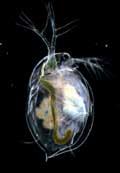As large as small
2011/02/08 Kortabitarte Egiguren, Irati - Elhuyar Zientzia

The genome of aquatic pulacusa Daphnia pulex has been sequenced by project manager John Colbourne of the University of Indiana and an international research team. It is the first time they sequence the genome of a crustacean.
This small freshwater flea contains many genes, more than any other species sequenced so far. In addition, more than a third of the genes belong to the Daphnia family. Researchers believe that these genes are responsible for the ability of fleas to adapt to different media.
These water fleas are transparent, short-lived and easily clonable. It also responds easily to changes in the environment. For example, protective spines and several teeth develop in the tail to combat the chemicals released by some predators.
According to the researchers, the sequencing of this genome will help us better understand how organisms, especially freshwater organisms, react to environmental changes.Image courtesy of: D. Paul N. Hebert/University of Guelph.

Gai honi buruzko eduki gehiago
Elhuyarrek garatutako teknologia






